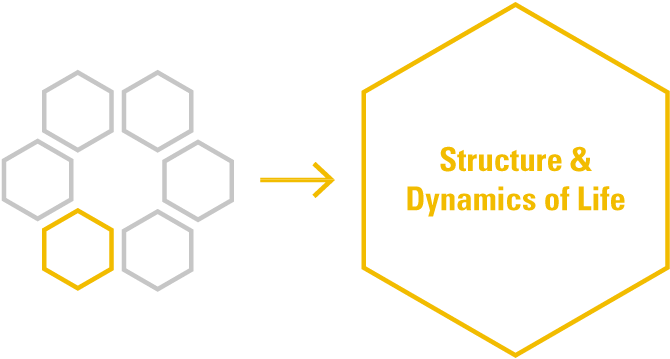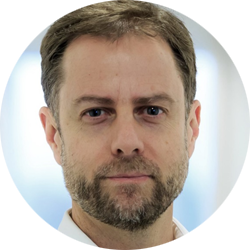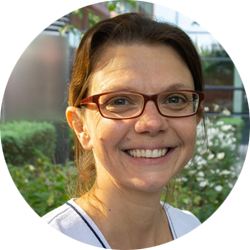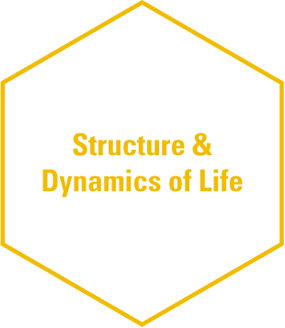- GU Home
- Research at Goethe University
- Profile Area Structure & Dynamics of Life

Mission Statement


Profile Area Spokespersons

Alexander Heckel (Chemical Biology)
Spokesperson of the Profile Area Structure & Dynamics of Life

“Cells are the basic units of life. To understand how biological systems function, we must have a deep understanding of the building blocks that make up cells and how they fit together to form their highly complex internal structure. We also need to grasp how this structure dynamically self-assembles, maintains its equilibrium and continuously remodels itself to adapt to the environment, both under healthy and pathological conditions. These are to me the challenging oals of the Profile Area."
Virginie Lecaudey (Cell Biology and Neuroscience)
Spokesperson of the Profile Area Structure & Dynamics of Life

Key Research Areas

To address these questions, scientists need instruments and tools allowing them to study and interfere with biological systems at these very different spatiotemporal scales. For this reason, Goethe University maintains centers for nuclear magnetic resonance and mass spectroscopy, as well as electron and optical microscopy. In addition, essential tools are specially built to induce light-driven processes. In this context, the genetic manipulation of organisms plays a crucial role to observe the diverse processes under physiological conditions.
Currently, the SCALE (SubCellular Architecture of LifE) consortium is preparing a full proposal for the Cluster of Excellence funding line in the context of the Excellence Strategy (ExStra). SCALE, integrating many scientists of the Profile Area, brings together expertise from cell biology, biophysics, molecular biology, neurobiology, chemistry, bioinformatics and mathematics. It will develop radically novel experimental techniques to map and to simulate the interior of cells, and to predict their behavior. This research will provide important new insights into bacterial resistance, inflammation, neurodegenerative diseases and immune defense.
Other main research themes in SDL include RNA-based processes, membrane and organelle dynamics, neuronal molecular and cellular architectures, cell-cell interactions, and light-driven processes, as well as their many interconnections.
RNA-based processes
Membrane and organelle dynamics
Neuronal molecular and cellular architectures
Light-based tools
Structures in live cells

Coordinated Research Projects
DFG (German Research Foundation)
- CRC 902 "Molecular Principles of RNA-based Regulation" (application for follow-up project currently under review)
- CRC 1039 "Lipid Signalling - Signalling by Fatty Acid Derivatives and Sphingolipids in Health and Disease"
- CRC 1080 "Molecular and Cellular Mechanisms of Neural Homeostasis"
- CRC 1177 "Molecular and Functional Characterization of Selective Autophagy"
- CRC 1507 "Membrane-Associated Protein Assemblies, Machineries and Supercomplexes"
- RTG 1986 "CliC - Complex Scenarios of Light-Control" (application for follow-up project currently under review)
- RTG 2336 "AVE - Resolution of Inflammation: Mediators, signaling and therapeutic options"
- RTG 2566 "ImoL - Interfacing image analysis and molecular life-science"
- FOR 5368 "ARENA - Abstract Representations in Neural Architectures"
- SPP 1926 "Next Generation Optogenetics: Tool Development and Application"
Associations:
- CRC 1315 "Mechanisms and Disturbances in Memory Consolidation: From Synapses to Systems" (HU Berlin)
- CRC 1399 "Mechanisms of Drug Sensitivity and Resistance in Small Cell Lung Cancer" (University of Cologne)
- CRC/TRR 135 "Cardinal Mechanisms of Perception: Prediction, Valuation, Categorization" (Gießen University, Marburg University)
HMWK (Hessian Ministry of Higher Education, Research, Science and the Arts)
Association:
- Cluster project "TAM - The Adaptive Mind" (Gießen University)
EU
- Research Infrastructure (Horizon Europe): "R-NMR – Remote NMR: Moving NMR infrastructures to remote access capabilities“
- Innovative Medicines Initiative (Horizon Europe): "EUbOPEN: Enabling and Unlocking Biology in the OPEN"
- Cost Action "RECROP - Reproductive Enhancement of CROP resilience to extreme climate"
Associations:
- European Innovation Council "B-BRIGTHER - Better Bioprinting by Light-Sheet Lithography“, coordinated by Mycronic AB (SWE)
- EU-Project "ISIDORE - Integrated Services for Infectious Disease Outbreak Research", coordinated by ERINHA (BEL)
Others:
- Cluster Initiative "SCALE - SubCellular Architecture of LifE"
VolkswagenStiftung
- Project "Target-RNA-antiV - Conserved RNA elements as novel drug targets for antiviral therapy“ (with TU Darmstadt)
- Prioject "CoVmacro - SARS-CoV-2 non-structural protein nsP3 macrodomain and viral replication“ (with RWTH Aachen, LMU Munich and Forschungszentrum Jülich)
Distinguished Individual Researchers
ERC-Grants
- Advanced Grant "EditMHC - How MHC-I editing complexes shape the hierarchical immune response" (Robert Tampé, FB 14)
- Consolidator Grant "AutoXitus - Molecular mechanisms and non-cell autonomous signalling" (Christian Münch, FB 16)
Emmy Noether Junior Research Groups
- Pericytes – a common link in the comorbidity of vascular impairment and Alzheimer's Disease (Jasmin Kim Hefendehl, FB 15)
- Cis- and trans-acting determinants of mRNA stability, structure and fate (Andreas Schlundt, FB 15)
- Peptide biosynthesis off the beaten path: Machine learning-guided discovery of non-canonical peptide natural products (Eric Helfrich, FB 15)
Heisenberg-Professorships
- New developments and approaches in native mass spectrometry (Nina Morgner, FB 14)
- Potassium transporters and channels in bacterial survival (Inga Hänelt, FB 14)
Lichtenberg Professorship
- Molecular Systems Medicine (Christian Münch, FB 16)
Institutions Involved
GRADE Centers
Institutions of Goethe University:
- BIC - Brain Imaging Center
- FCEM - Frankfurt Center for Electron Microscopy
- ICNF - Interdisciplinary Center for Neuroscience Frankfurt
- SGC - Structural Genomics Consortium Frankfurt
- BMLS - Buchmann Institute for Molecular Life Sciences
Cooperating Institutions:
- Studying at Goethe University
- International applicants
- Faculties
- Overview of study programmes
- Programme for refugees
- GRADE
- Goethe Business School (continuing education)
- Research at Goethe University
- Scientific news
- Goethe Welcome Center (for international researchers)
- Collaborative research projects
- Individual research
- Visiting fellowships
- Endowed chairs
- About the University
- News-in-brief
- University administration
- Campus locations
- Campus life
- University archives (German)
- Rhine-Main-Universities











